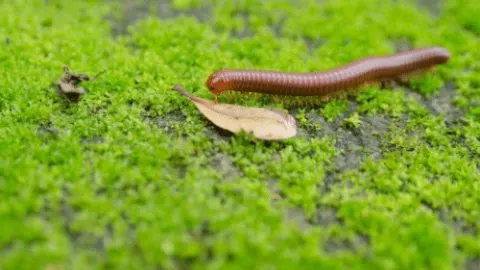One of the most common problems for houseplant owners is an infestation of their dear plants by insects.
The topic for today’s discussion is how to control millipedes in houseplants.
Do not be alarmed if you find Millipedes around your plant; as scary as they might look, eliminating them is fairly easy, and they do not cause significant damage if removed immediately and efficiently.
Millipedes are scavengers and are mostly herbivores.
They mostly eat dead plant material but will also be attracted to your plants.
They will also chomp on plant roots given the weather is wet, states the University of Milwaukee.
They do not harm humans but can certainly ruin your plants.
Millipedes are not insects, according to the University of Georgia. They are arthropods such as lobsters and shrimp.
How to Control Millipedes in Houseplants
To control millipedes in houseplants, pick them off, catch the millipedes with traps, attract animals such as frogs and doves to feed on the millipedes, use diatomaceous earth, spray chemicals, get rid of the potting soil, or use essential oils such as tea tree oil and peppermint oil.
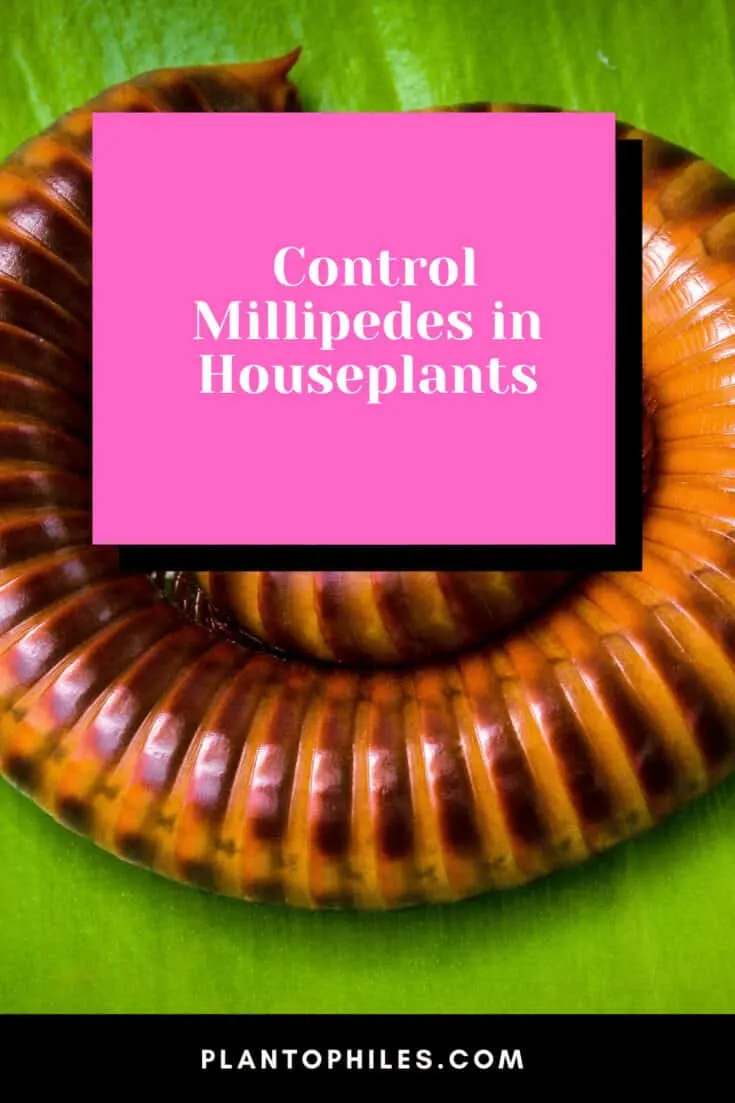
How to Control Millipedes in Houseplants
Table of Contents
What are Millipedes
To deal with any disease or insect infestation, knowing what it is is essential. Likewise, understanding what Millipedes are is also important.
Although similar to insects, they are classified as arthropods and possess an elongated body composed of several segments, with two pairs of legs.
Most of the Millipedes are herbivorous and tend to keep away from perpetually lit and dry environments.
Millipedes are attracted to moisture-rich places and dark locations such as the underground or under the stones and logs.
They do not feed on humans or damage buildings or furniture. However, they readily ingest plants and soil composts.
As surprising as it may sound, Millipedes can also be of considerable benefit; they can feed on the compost pile and decomposing plant matter.
The Millipedes break down the eaten contents and release them into their surroundings, ultimately enriching the soil with necessary nutrients.
Therefore, some plant lovers may also suggest you not to remove the Millipedes at all.
However, if things seem to be getting out of hand and your houseplants begin to suffer, it is best to remove the Millipedes before more damage occurs.
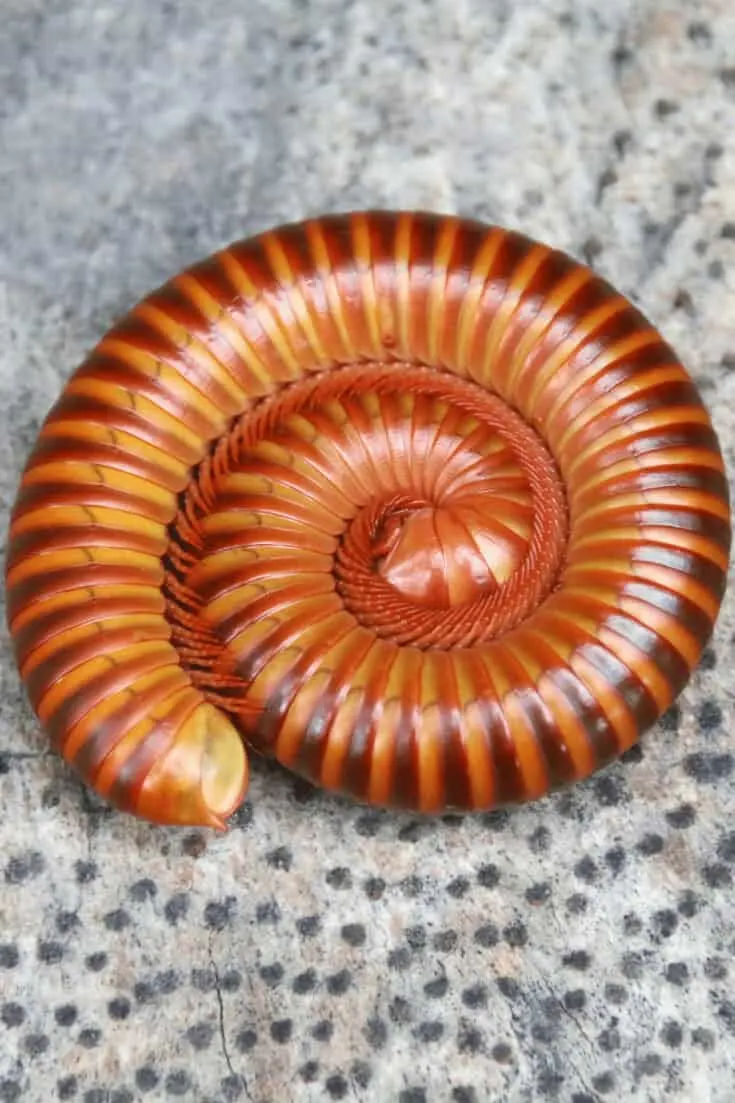
Millipedes are classified as arthropods
How to Remove Millipedes from Houseplants
There are numerous ways to get rid of Millipedes.
However, I recommend that you start with the mild and organic treatments before opting for the aggressive chemical-based ones.
If you can eliminate them with the easier options, using harsh chemicals, such as pesticides, is not required.
Millipedes can be of good use till they are only feeding on your dead plants or soil compost.
But, you may have to take action when they start infesting your seedlings and young shoots, and plants.
Another indication of removing Millipedes is when they multiply too fast, and you see more of them and less of your plants.
Pick the Millipedes off
You can start with the simplest way: pick the Millipedes off the houseplants with your hands or plant forceps.
The former option, removing the Millipedes manually, is definitely a way chosen by the brave-hearted. It is an easy and quick choice for those who are not squeamish about touching bugs in their garden.
The individuals who prefer not to hold the Millipedes directly can simply grab plant forceps or similar gardening tools and pick off the Millipedes with them.
Although a little tricky, this method is fairly safe and minimizes the probability of you developing any allergies.
Alternatively, you can purchase a shop vac and use this to suck up the Millipedes and dispose of them far away from your houseplants.
However, please ensure that you do not suck excessively and get rid of them as soon as you catch them in the shop vac.
Direct hand usage and plant tools are both acceptable. However, care must be taken not to put too much stress or squish the millipedes.
These pests release an unusual chemical that causes an unpleasant smell. Likewise, this foul smell may also lead to allergies and feelings of extreme discomfort.
Rarely some Millipedes can bite your hand while you are holding them. The bite can cause intense irritation or, possibly, mild poisoning.
Therefore, the best way to manually pick off any pests, including Millipedes, is to do it with gloves.
If you are sensitive to strong smells, I advise you to wear a mask or simply close your nose temporarily with a nose pin. Moreover, wear protective clothing, if necessary.
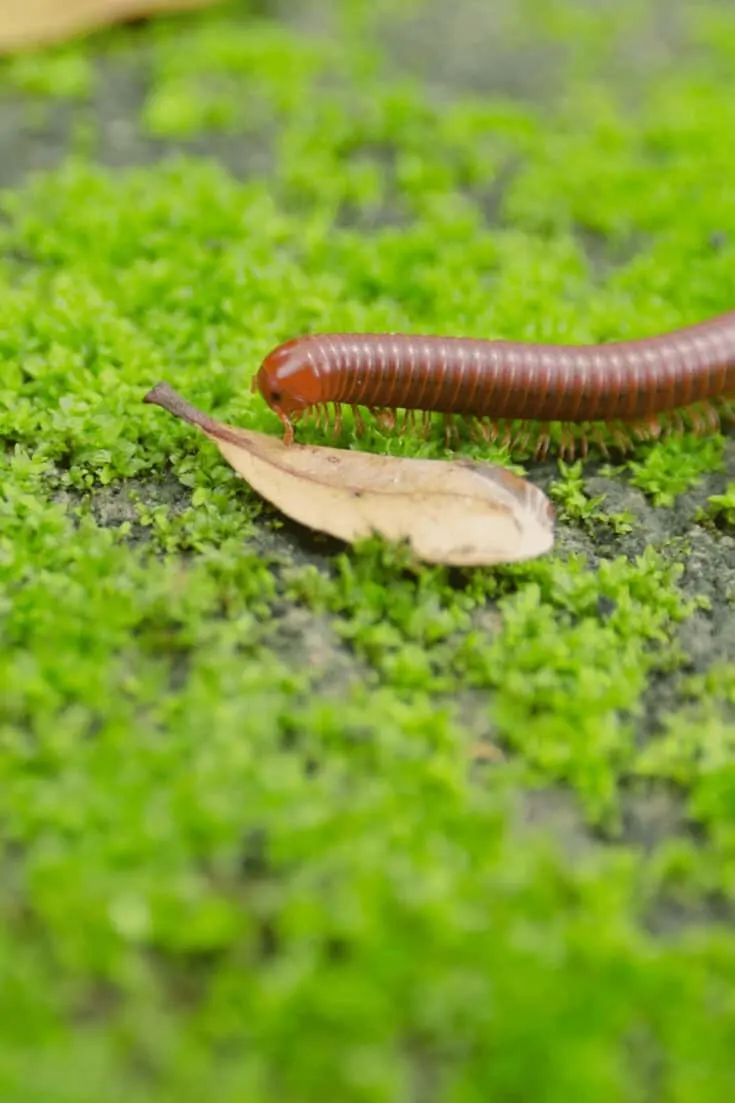
Pick the Millipedes off if there are not too many
Catch the Millipedes with Traps
If you would rather not get close to the Millipedes, removing them by catching them is another way. Simply form one of the traps below:
Plastic Bottle Trap
To make this, gather the following:
- Plastic/Soda bottle with a cap
- Vinyl tubing (can be purchased from a hardware store)
- Tape
- Pocket or kitchen knife
- Piece(s) of ripe fruit
Put the ripe fruit inside the plastic/soda bottle; this will bring the Millipedes towards and inside the bottle.
Take your vinyl tubing and insert it into the plastic bottle. If it is the same width as the plastic bottle’s mouth, directly put it in.
However, if it is a different size, make a small hole in the bottle’s cap with the kitchen or pocket knife and then insert the vinyl tubing inside.
Put the vinyl tubing in the bottle so that approximately the tubing’s 2-inch is inside the plastic bottle.
Also, please ensure that the vinyl tubing does not touch the plastic bottle’s sides.
To secure the tubing to the bottle, use some tape. This will prevent the tubing from sticking out of the bottle and help it remain in place.
Now place the plastic bottle trap, with the taped vinyl tubing, in the Millipedes infested potting soil or close to the infested plant.
The trick is to keep the plastic bottle lying on its side with the mouth in contact with the soil, possibly.
The Millipedes are most likely to be attracted towards the fruit piece and move inside the plastic bottle to feed on the treat.
Once inside, the Millipedes will not be able to crawl back out due to the constricted mouth.
Continue doing this until all the Millipedes are removed from the plant. Every day, take this plastic bottle filled with these pests and release the Millipedes far away from your plants.
This method may take some time but is reasonably budget-friendly and helps remove a considerable number of the Millipedes.
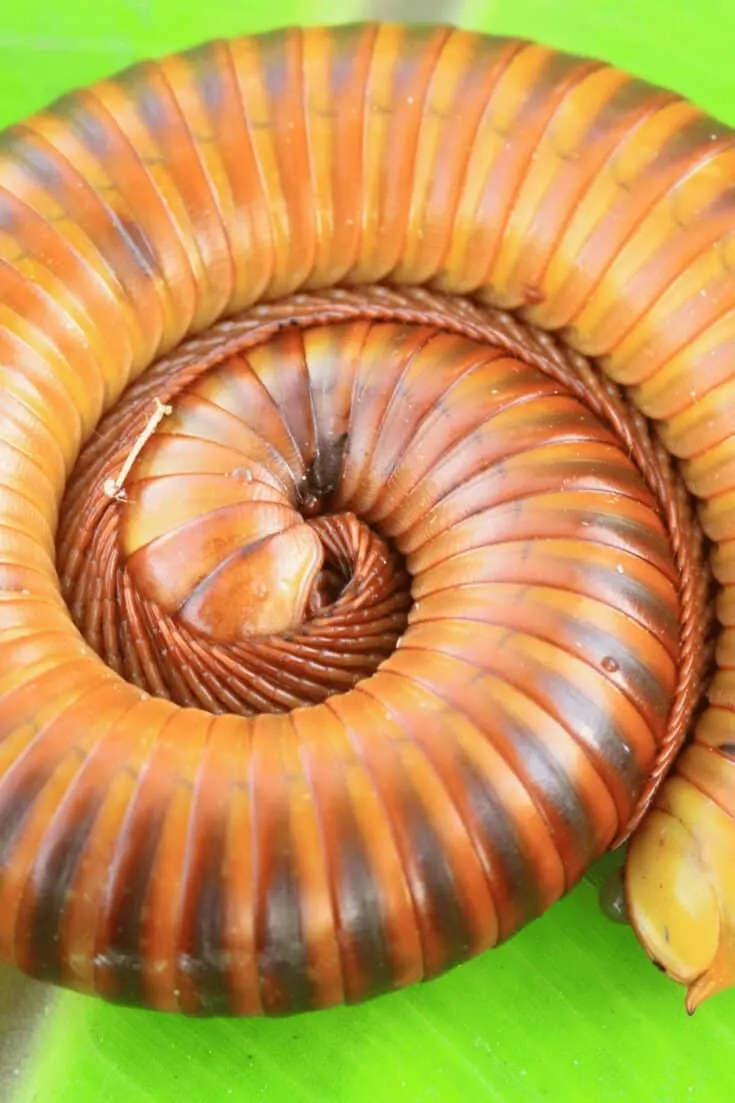
Catch the Millipedes with Traps
LED Light Trap
If your houseplants are placed outdoors, this trick can work fairly well for you in your garden or terrace.
The Millipedes gravitate towards a bright light, and you can use this characteristic of theirs to trap them.
Collect the following:
- A deep container (preferably a food container)
- A bucket that can easily cover the deep container
- A bright LED light (preferably battery-powered)
- Water
- Shovel
- Pair of cutters
- Tape
Take the shovel to make a hole in your garden close to the infested potted plants. The hole should be deep enough for the food container to fit inside.
Make sure that the container’s rim is at the same height as the ground soil’s surface.
Next, cover the container’s sides with the soil so that it does not budge and is considerably tight; you should leave no gaps. Add some water into the food container till it is full.
Now grab the cutters and make some narrow slits in the bucket’s top. These slits will serve as passages for the Millipedes to enter the inside of the bucket.
Next, take the tape and stick the battery-powered LED light on the bottom of the bucket with its help.
Now, put the bucket upside down over the deep container filled with water. This will effectively cover the container, preventing the escape of the Millipedes.
During the nights, turn the LED light on; this will attract the Millipedes towards the warm glow.
Once they enter, the Millipedes will fall into the container and drown overnight.
Each morning, check for the drowned Millipedes in the food container and get rid of the water. Repeat this with replaced fresh water till all Millipedes are eliminated.
Attract Animals to Feed on the Millipedes
Just like the Millipedes love feeding on plants, some animals like feasting the Millipedes.
The only hassle is to bring these animals to your garden, close to your damaged houseplants. This method works best for outdoor plants.
Several animals, like toads, frogs, pigeons, and ravens, like to feed on the Millipedes.
Another option is to borrow or raise some chicken that eats Millipedes and similar pests. Chickens are also a great source of eggs and manure.
Simply put the appropriate animal feed, such as of the chickens or the pigeons, in your garden and allow them to feed on it.
The chances are that once the chickens and pigeons begin eating the distributed feed, they will find the Millipedes all by themselves and begin ingesting them. Repeat this method till you get rid of the Millipedes.
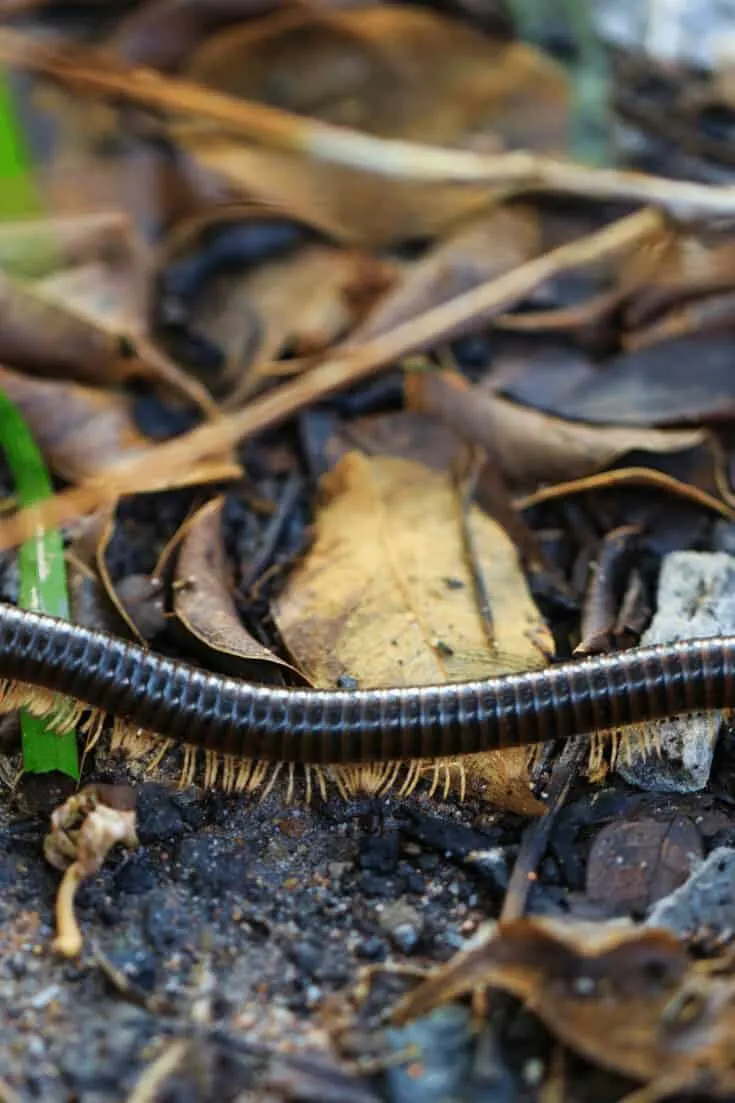
Most Millipedes are herbivorous
Diatomaceous Earth
Fossilized microscopic organisms, known as Diatoms, are called Diatomaceous Earth.
These organisms are found close to river beds, streams, oceans, lakes, and similar water bodies.
The Diatomaceous Earth, in powder form, is ideal for removing Anthropods like Millipedes.
The Diatomaceous Earth not only works against Millipedes but also aphids, mealybugs, mites, and Japanese beetles. The powdered food-grade Diatomaceous Earth is available at local garden centers and some online stores.
The Diatomaceous Earth powder has pointed microscopic edges often lodged in such insects’ joints.
These sharp boundaries cut the outer shell of the Anthropods, damaging their bodies and dehydrating them.
The dehydrated insects, Millipedes in this case, ultimately die.
If you do not wish to spread the Diatomaceous Earth powder in the soil, you can alternatively spray it upon your infested houseplants.
Once the Millipedes come into contact with the poisonous powder, they will be killed. However, the Diatomaceous Earth powder is organic and may take up a few days till it adversely affects the Millipedes.
As mentioned, the Diatomaceous Earth powder is mildly poisonous.
Therefore, you must only spray it when there are no kids or pets around and are kept away from it until the powder’s effects die down.
Moreover, please avoid inhaling it and wear a mask when spraying the Diatomaceous Earth powder. Although not fatal, the Diatomaceous Earth powder can cause significant irritation in the lungs when taken in.
To dilute it and ensure that it does not fly around or away from the affected plants, mix the Diatomaceous Earth powder with water and then spray it.
When the water dries out, the powder becomes concentrated and begins showing its magic.
An alternative is Boric Acid, which can be bought from the laundry section at any shopping center.
The Boric Acid has a similar working mechanism; it slices the Millipedes with its sharp microscopic edges, damaging their outer coat.
The Millipedes are left dehydrated and, eventually, killed.
I suggest using the Boric Acid only if you have pets and children around. Generally, the Diatomaceous Earth powder proves to be more effective than the Boric Acid.
Spray Chemicals
I recommend saving this method as one of your last resorts when all other techniques inadequately control the Millipedes and their number multiplies significantly.
Likewise, please refrain from opting for this option, as the chemical spray can also contaminate your vegetables and fruits if you are growing any in the same area as the infested plants.
Add some chemical pesticides to your houseplants’ soil. The pesticides will get rid of the Millipedes fairly quickly; however, they will stay in the potting soil mix for some time.
The chemicals may also cause some of the beneficial insects living in the soil to die.
The chemicals that usually prove to be most effective against Millipedes include Bendiocard, Cyfluthrin, Carbaryl, Propoxur, and Pyrethrin. Therefore, purchase pesticides containing one or more of these chemicals.
I strongly advise you to follow the exact instructions mentioned in the chemical pesticides’ packing and use them accordingly.
Adding an excessive amount of the pesticide may permanently extract the soil from its nutrients, kill the beneficial insects, and cause greater damage to the plant, possibly killing it.
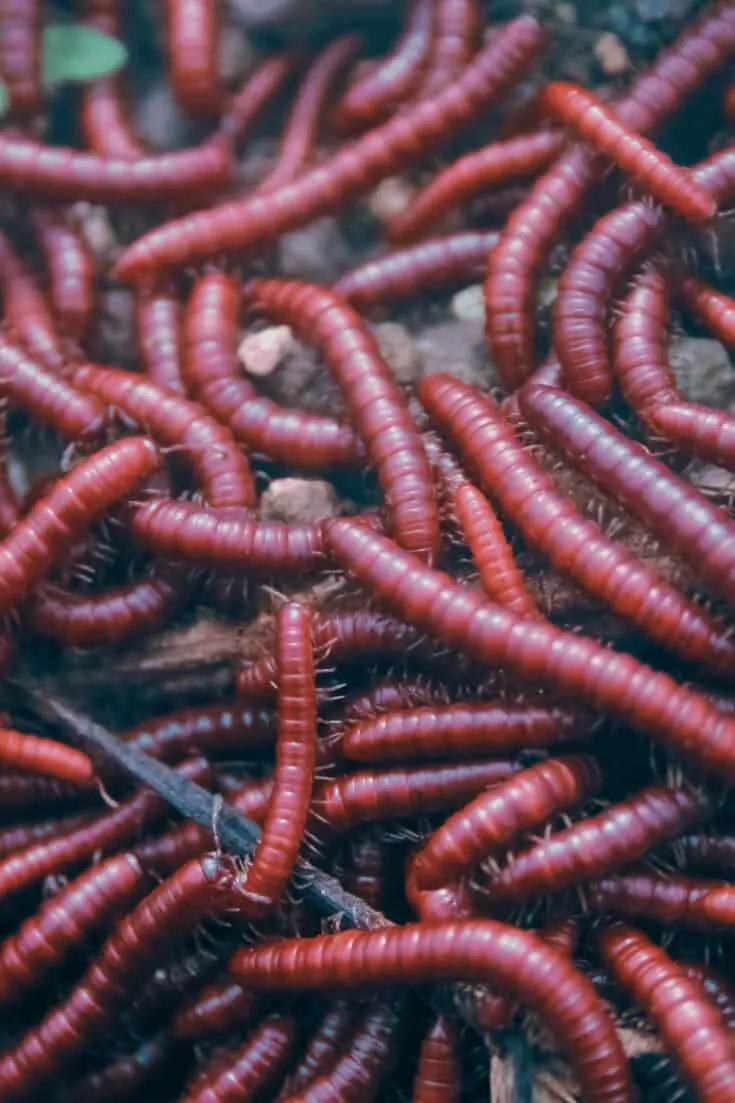
Only spray chemicals as a last resort when things get out of hand
Disposing of the Potted Soil
If the number of Millipedes has extended far beyond control and there seems no effective way to manage them, it is best that you get rid of the infested potting soil itself.
Please remember to dispose of the soil only, not the entire plant.
After you throw away the soil, transplant your beloved houseplant from its old pot to a new, clean one.
However, please ensure that you first pick out all the Millipedes on the plant and then transfer it to another potting container.
The new pot should be disinfected and appropriately sized. Fill this pot with fresh potting soil and put the plant in it.
Now, hold the plant’s base and gently tap on the pot to loosen the plant’s root ball.
Once you have taken your plant out of its old pot, remove as much old potting soil as you possibly can from its roots.
In the new pot, make a central hole for the plant. Place the plant’s roots in this hole and make sure the plant stands upright.
Add some more potting soil and water it; drain the excess water from the bottom.
Please do not just throw the old potting soil anywhere, as if too close, the Millipedes may crawl towards your plants again.
Release the infected soil far away from your plants; however, you may reuse the pot.
To clean the pot, soak it into a mix of 1 part bleach and 9 parts water for an hour or more.
Once thoroughly soaked for a reasonable amount of time, wash and dry it off to reuse.
Essential Oils
Essential oils may not eliminate the Millipedes for you; however, the oils will undoubtedly discourage the Millipedes from residing on ingesting your plants.
Some effective essential oils include tea tree oil and peppermint oil. Both these oils have strong odors that repel the Millipedes.
To use the essential oils against the Millipedes, prepare a diluted mix. Combine the essential oil with some water, and then spray it on the affected plant.
Please avoid using the essential oil alone, as it may be highly concentrated, and burn the plant instead of treating it.
Always follow the guidelines mentioned by the manufacturer on the product packaging. Generally, 1 ounce of essential oil is added to a gallon of water.
Once prepared, spray the essential oil mixture thoroughly over the plant’s soil, as well as its leaves.
Please keep your pets and children away from this area for some time.
Furthermore, if you have any, wash the vegetables growing in this area before consuming them.
Alternate Methods
There are also some other easy preventative ways to minimize the attack of Millipedes. They include:
- Cleaning your garden regularly and removing dead and damaged plant matter; dead matter attracts Millipedes.
- Remove any unnecessary props or clutter that insects, such as Millipedes and snails, might use for cover and shelter.
- Avoid overwatering your plants, as damp environments attract Millipedes.
- Always drain the excess water from your plants and use freely draining pots.
Frequently Asked Questions
How do I get rid of the Millipedes smell?
Use gardening gloves while treating infected plants and use baking soda, bleach, or vinegar to eliminate the smell.
How do I prevent a Millipede attack?
Refrain from keeping your plants in damp environments; please do not overwater them, over-spray them, and drain them well.
Are Millipedes toxic?
Millipedes are toxic to plants only. However, they may cause severe allergy and breathing difficulties. Therefore, do not directly touch them and keep your pets and children away from Millipedes-infested areas.
Conclusion
Millipedes are a type of insect that is attracted to damp areas. Within a limited number, they do not cause significant damage.
However, if their number exceeds a certain limit, they may considerably harm young plants and shoots.
Therefore, monitor your plants’ moisture levels and keep their surroundings clean.
Moreover, take all necessary precautionary measures when treating infected plants and keep your pets and children away from Millipedes.

Daniel has been a plant enthusiast for over 20 years. He owns hundreds of houseplants and prepares for the chili growing seasons yearly with great anticipation. His favorite plants are plant species in the Araceae family, such as Monstera, Philodendron, and Anthurium. He also loves gardening and is growing hot peppers, tomatoes, and many more vegetables.

